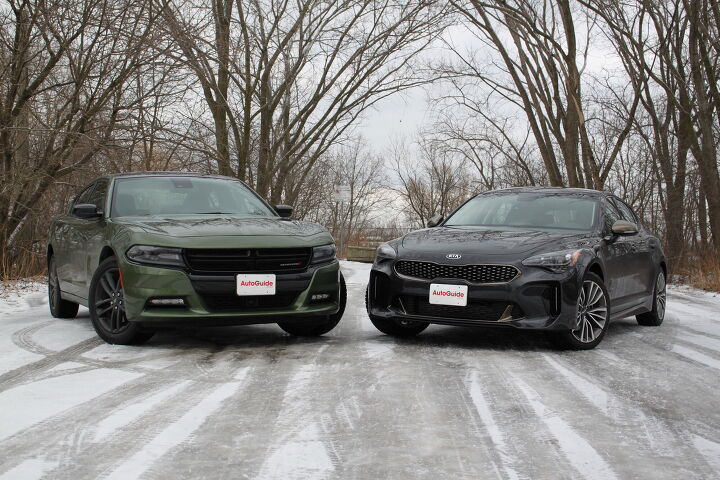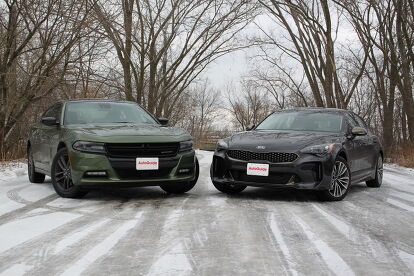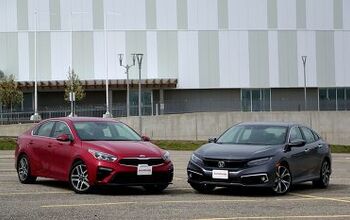2019 Kia Stinger Vs Dodge Charger Comparison

You’ve probably heard by now that sedans are not selling as well as they used to. The once popular body style is losing favor to the more family-friendly and rugged SUV, which offers all-wheel drive capability in addition to more space.
A few large family sedans still exist, and there’s even a new one that brings a different body style and format to the segment. The Kia Stinger impressed us so many times with its combination of sleek styling, luxury appointments, size, and fun driving dynamics. We decided it was a good idea to bring another large, popular, and sporty sedan to compare it to — something that represents the old guard in this segment — so the Dodge Charger came along.
At first glance, the two cars don’t seem to have a lot in common, and indeed, they’re very different, but they both make a very strong case for the big family sedan.
Powertrains
Both of these sedans arrived with all-wheel drive and the base engine, a four-cylinder turbo in the Stinger and a V6 in the Charger. Having them in the thick of winter meant that driving the AWD models was much preferred over the more affordable rear-drive base models (only AWD Stingers are available in Canada).
The Stinger uses a 2.0-liter turbo four that makes 255 horsepower and 260 lb-ft of torque. It feels great once in motion, but there’s a distinct feeling of hesitation or turbo lag off the line. This is a small hiccup that doesn’t impact the driving experience in any significant way. The car feels sporty and eager to pass on the road, never feeling hampered by its relatively small engine. Sure, it doesn’t have the grunt and oomph of the Stinger GT’s 365-horsepower twin-turbo V6, but it still gets the right point across. Expect to get about 24 MPG combined from the four-cylinder, all-wheel-drive Stinger. I like the eight-speed automatic in the Stinger a bit more than the one in the Charger, as its gear changes are quick and crisp.
The Charger uses a naturally aspirated engine, a 3.6-liter V6 engine that makes 300 horsepower and 264 lb-ft of torque. It feels a touch more responsive than the turbo four in the Kia and comes without the hesitation that the smaller engine has from a standstill. The engine sounds pretty good when pushed, which is a nice surprise. The eight-speed automatic feels less refined, with slushy, slow shifts, and the car doesn’t return the most impressive fuel economy figures, with a combined rating of 21 MPG. Still, there are many features to help improve the car’s economy, including a front-axle disconnect system that lets the car drive only the rear wheels when all-wheel drive isn’t needed.
See Also: Dodge Durango SRT vs Chevrolet Tahoe RST
Size
The Stinger is a tiny bit shorter in overall length when compared to the Charger, with a smaller wheelbase as well. This makes it feel more agile. Despite its smaller dimensions, however, the Stinger doesn’t feel cramped inside. There’s barely half an inch less headroom in the front of the vehicle when compared to the Dodge, and a little more than half an inch more rear passenger headroom in the Stinger. There’s also more legroom in the front of the Kia than in the Dodge, but the Charger has much more available legroom in the back. Finally, the Stinger has a liftback design, which gives it a much more practical and accommodating trunk with 23.3 cubic feet of cargo capacity.
The Charger is larger in almost every dimension, and the long wheelbase helps the sedan feel stable and smooth. Getting in and out of the sedan is also easy with its large openings. While the Stinger is great for four people, the Charger can accommodate a fifth passenger with ease.
On the Road
The Kia Stinger is responsive and exciting to drive. It lives up to the sports sedan classification with a tight and engaging feel. There’s a solid steering weight and the vehicle has impressive handling for its size. It feels nimble, yet not tinny or darty, which is important for a large sedan. The car also has a number of drive modes to help it match your driving style.
See Also: 2019 Dodge Charger Gets Fresh Face and New Equipment
The Charger, on the other hand, can feel a bit lumbering and large. While it never feels as agile or sporty, it does feel very composed on the highway, where it can easily handle miles and miles of highway commute without complaint. The ride is softer and a bit less engaging. This vehicle has drive modes as well, but they never feel noticeably different than one another.
It’s easy to see that these two cars contrast one another. The Stinger is a sporty sedan with lots of space, while the Charger is an aggressive looking large sedan that’s perfect for the family. In the Charger, you’ll find yourself feeling like you’re sitting at the same height as some crossovers, while the Stinger feels far lower and sportier in comparison.
Features and Pricing
Our four-cylinder turbocharged Stinger with all-wheel-drive doesn’t come standard with many of the advanced driver assistance features. You won’t find adaptive cruise control or lane keeping assistance in this car unless you opt for additional packages or a different trim level. Our model also featured the smaller seven-inch infotainment system that lacked navigation but included Apple CarPlay and Android Auto support. Fortunately, it had a heated steering wheel and heated front seats, as well as dual-zone climate control and wireless phone charger. As tested, it rings it at about $36,185.
The Charger can be had with plenty of options and our model had it all. Our tester also included an appearance package and an upgraded paint finish, which is why it’s done up in that gorgeous green. It too featured the Plus Group, and a navigation system for a total price of $38,255, if you didn’t opt for all the superficial packages. With the Blacktop packages and upgraded paint, it’ll set you back $39,250. It’s a bit more expensive, but you have more power and more space for passengers.
The Verdict: Kia Stinger vs Dodge Charger Comparison
However, that’s just a tiny bit of the comparison. While the Dodge Charger is more popular, and versatile (offering so many configurations of engines, drivetrains, and features) it feels very dated in terms of driving dynamics. The Stinger has more cargo space, feels more premium and features a more modern, fuel-efficient powertrain. As tested, even without the Charger’s appearance package, it’s more affordable too, making it a better all-around choice for buyers looking for a larger, all-wheel-drive sedan that doesn’t break the bank.

Sami has an unquenchable thirst for car knowledge and has been at AutoGuide for the past six years. He has a degree in journalism and media studies from the University of Guelph-Humber in Toronto and has won multiple journalism awards from the Automotive Journalist Association of Canada. Sami is also on the jury for the World Car Awards.
More by Sami Haj-Assaad



























































































Comments
Join the conversation